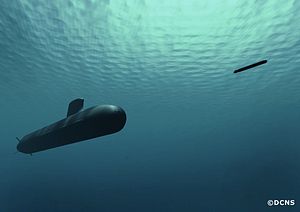Australian Prime Minister Malcolm Turnbull and French Minister for Defense Jean-Yves Le Drian signed an intergovernmental agreement (IGA) for the construction of Australia’s future submarine fleet on December 20, according to an Australian government press release.
The agreement establishes the legal framework for the development and construction of 12 Shortfin Barracuda Block 1A submarines, a diesel-electric derivative of French shipbuilder Direction des Constructions Navales Services’ (DCNS) Barracuda-class nuclear attack submarine under the Royal Australian Navy’s SEA 1000 Future Submarine Program.
“The IGA is the last foundation stone needed to ensure Australia is able to develop a cutting edge sovereign submarine capability. It follows the selection of French company DCNS as Australia’s Future Submarine design and mobilization partner and Lockheed Martin Australia as the combat system integrator,” Turnbull said in a prepared statement.
As I reported previously (See: “Australia’s New Subs to Operate Lockheed Martin Combat System”), the RAN selected a submarine combat system — the heart and brain of a submarine — manufactured by U.S. defense contractor Lockheed Martin for the Shortfin Barracuda-class.
On December 20, DCNS also inaugurated its headquarters, named DCNS Australia Adelaide Future Submarine Facility, in the capital city of the state of South Australia. The 12 submarines — except for some specialized parts — will be constructed in Adelaide, home to the Australian Submarine Corporation (ASC). “The Future Submarine Program will generate thousands of jobs in Australia and will be a significant part of our defense capability well into the second half of this century,” the prime minister said.
In a separate statement, Australia’s minister for defense, Marise Payne, noted that “Australia’s 2016 Defense White Paper established the need for a highly sophisticated and regionally superior submarine fleet. (…) The agreement signed today will enable France to transfer cutting-edge skills, knowledge and technology to the Australian Government and Australian industry to achieve a sovereign operational and sustainment submarine capability in Australia.”
Last week, Australia and France also signed a bilateral agreement to share classified information on defense programs, including sensitive defense technologies related to Australia’s new submarine fleet, as The Diplomat reported. The document was signed by Australia’s attorney-general, George Brandis, and the French defense minister.
The estimated A$50 billion (US$38.13 billion) deal with DCNS came under public scrutiny this August when a massive leak of documents detailed combat capabilities of the Indian Navy’s Scorpene-class (Kalvari-class) diesel-electric attack submarine. The DCNS has been building the Scorpene-class with the support of India’s state-run Mazgaon Docks Limited in Mumbai for the past decade (See: “Top Secret Data on India’s New Stealth Attack Submarine Leaked”).
































